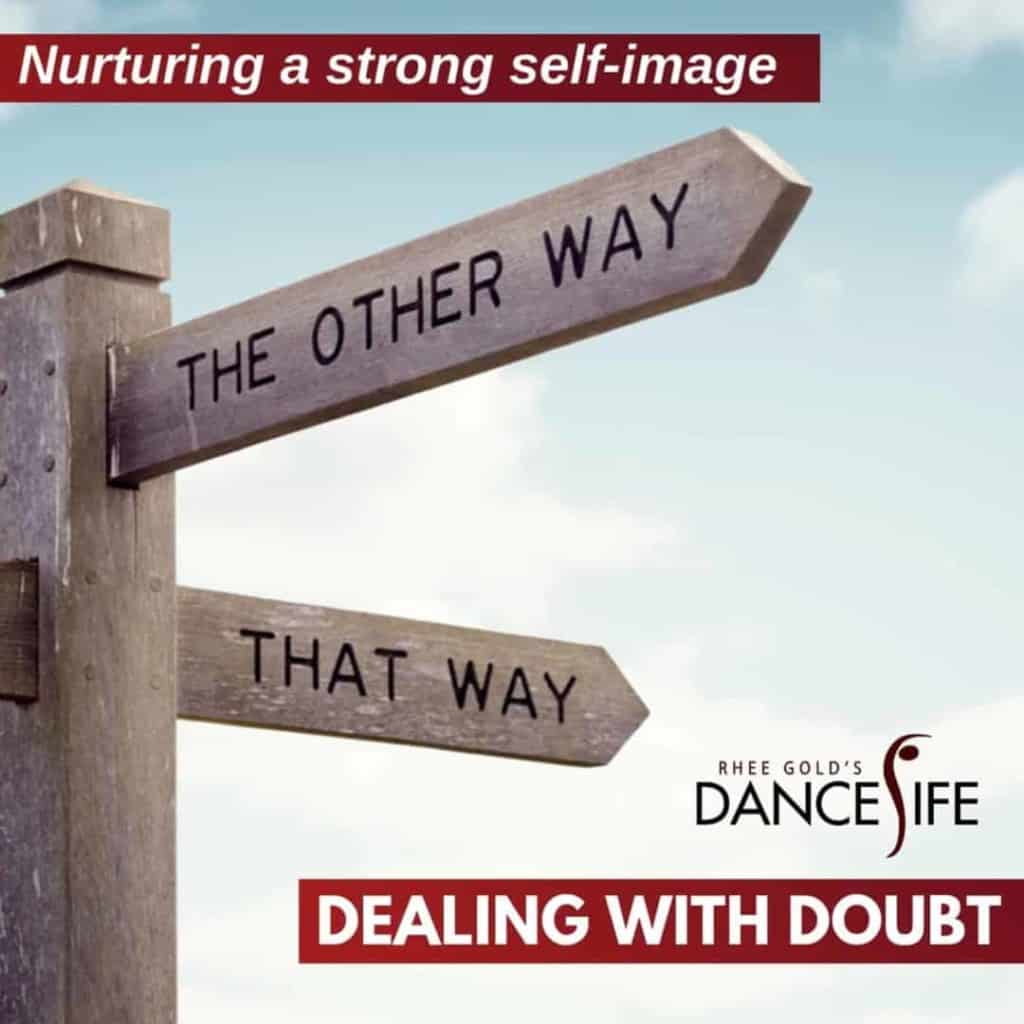Dealing With Doubt

by Suzanne Martin, PT, DPT
Make a positive impression by nurturing a strong self-image
Successful teaching demands that the instructor take command of her material and her classroom with authority. This can be tough, especially when you’re just launching a teaching career. Think about when you first started teaching. Did you come roaring out of the gate, full of confidence, or do you still sometimes struggle with doubts about your qualifications, teaching abilities, or leadership qualities?
My first experience teaching ballet was as a dance major, in the children’s division. Was I prepared? No. It was trial by fire, with me imitating the structure and format I had been taught. Sometimes this was a good strategy and sometimes it wasn’t; it took time and experience to see what worked for me. And even years later, after earning my master’s degree and a California teaching credential, I realize that I do not have every solution for every teaching problem; no one does.
Teaching movement is like raising children: it doesn’t come with a manual. Even if you went through a program to learn, for example, the Vaganova or RAD syllabus, it’s still you and your students in a room. And just like in live performance, stuff happens—the kind of stuff that can rattle confidence and instill self-doubt.
Here are some tips and thoughts to help you set yourself up to be the kind of teacher who commands trust, respect, and authority.
Communicating
Teaching is public speaking. And, as with most public speaking, it’s important to communicate efficiently. Being succinct and getting the point across quickly require thinking ahead. My 10-minute presentations, especially in high-pressure situations like international forums, are much harder than presenting for a whole hour.
The good news is that dance pedagogy is not new. We all had teachers, probably lots of them. Think back to your many hours of class time with them. Remember how brief the explanation and correction times were in relation to the actual time spent moving. You’re probably still taking class. Watch your teachers, notice what they’re seeing, and listen to how they communicate. Then practice knowing what to say and saying it clearly and concisely.
Authority
When you start teaching a class, set the tone right away. You can take authority of the class simply by stating, “I am your ballet [or whatever style it is] teacher.”
Be sure to give credit where credit is due. One of the most brazen statements I’ve ever heard, and one that left me with an exceptionally negative first impression, came from a successful fitness entrepreneur who boldly announced at the beginning of a workshop that she was “self-taught.” How could she be entirely self-taught? I was struck by her readiness to dismiss or deny the importance and influence of those who had gone before her.
Acknowledging other influences and being positive about them is a plus. Stir up some excitement by being inclusive and showing your breadth and network of knowledge. Show that you have a team behind you. The work you did to absorb all that experience and knowledge will only give your students and their parents more confidence in your abilities. And of course you want to show your appreciation for your teachers and mentors.
Firmly but kindly set expectations, starting with tardiness. Accidents and emergencies are a fact of life, but let the class know your policies on late arrivals and makeup classes. Be equally firm when you lay out your rules about dress and conduct code.
Conduct expectations inside the class may need to be reinforced. Take charge. Disruptive students need to be told when to stop, and perpetually inquisitive students may need to be told that question time is over in order to keep the class on pace.
Disrespectful behavior like eye rolling, crankiness, impatience, and tantrums can be humorously yet effectively addressed. Sometimes a cheerful, “Isn’t this fun?” or “It gets even better!” during a particularly grueling or tedious exercise can prevent a negative aura from overtaking the studio.
As we all know, training can be arduous; lightening the mood can be a needed coping strategy for all involved. Learn to modulate your voice by elevating and lowering the pitch, tone, and delivery. For instance, a downward pitch adds authority and emphasis: “The important part of this dégagé combination is feeling your foot digging into the floor.” A higher pitch with a tempo change (for example, “I was wondering . . .”) engages the listener since a response will be required. And repetition drives home a point; usually people need to hear something three times to really register it.
Finding voice, building structure, and developing substance
In my early years of teaching, I began by imitating the teachers I had admired in my training. In addition to incorporating material I’d learned from them, I mimicked the words of my favorite teachers, along with their mannerisms that conveyed authority, humor, or observational acuity. I found that if I started out acting “as if” by following my mentors’ lead, I began to develop confidence, and soon found my own voice.
In planning and structuring a class, start with the basics. From elementary school onward, we learn that sentences have a beginning, a middle, and an end, just as choreography, a symphony, or a novel does. In dance terms, this translates to warm-up or barre, center floor variations, and across-the-floor combinations, pretty much for any style of dance. It’s a simple structure, but it provides a solid base on which to build any class.
On top of that structure, layer your movement and music. Then instill a theme such as “coordinating internal focus with external focus,” or even something as concrete as facing all directions in the room.
Invest the time to prepare a solid set of class plans. You can adapt these plans and materials later to create new classes, so you’ve given yourself something you can use for many years.
Mutual respect and integrity
If you doubt your students, they will have no reason to have confidence in you. Think highly of your students and treat them with respect. Consider yourself a diplomat and advocate for dance.
Integrity counts and adherence to principle never goes out of style. Treating everyone fairly, showing up on time, being prepared, and not gossiping about students, your work conditions, or the students’ parents (even if they’re crazed with anxiety) pays off.
It’s important not to let the inevitable small fluctuations of public opinion undermine your confidence or self-esteem. As performers, we all want to please our audiences. It’s hard to believe that with all our hard work not everyone will like or accept us, or that some people will go so far as to talk about us. But that’s part of teaching or running a studio. Parents will ask questions about what goes on in class and students will talk about their perceptions and experiences. That’s why it’s important to keep your eyes on the prize: teaching your best class, running the best studio, and delivering the best you can for your students and their families.
Feedback
Being open to feedback does help, even though it’s important not to overreact to perceived disapproval. After all, no one is perfect. It can be easier at first to solicit input and suggestions from your peers than to find out the hard way from parents that, indeed, there’s much room for improvement.
Listen to the feedback from your peers about how your verbal language, body language, and lesson plans come across. Criticism can be shocking, even if you’ve asked for it. But it can help you become a better you.
Try to forget about feeling wounded. Think of the criticism as pure information. Then decide what to do with it. Is it reasonable to change how you do things to make parents, students, or other teachers more comfortable, safe, or engaged? Is it possible to meet the other person’s demands by making a minor change that will create a win–win situation?
For example, if you teach while sitting down in class, people might think you’re not attentive or engaged. Respond to that criticism with a small change in behavior, perhaps something as simple as circling through the studio every other exercise.
Listen to others’ comments with an open, receptive stance—arms uncrossed—and reflect back information to acknowledge that you’ve heard what is being said. Ask for suggestions. Once you know what needs changing, vow to practice what you’ve learned or decided to change.
One of life’s most challenging tasks is looking at oneself honestly. But as difficult as it may be, if you do the hard work of self-scrutiny, it will pay off. Remember that looking at yourself is not going to reveal only bad things. You will find plenty of things you’re doing quite well, even exactly right.
With solid preparation, a clear understanding of your role as a teacher or owner, and positive, open communication skills, you will find your voice: confident, competent, and authoritative. And people will listen.
I have faith in you.





